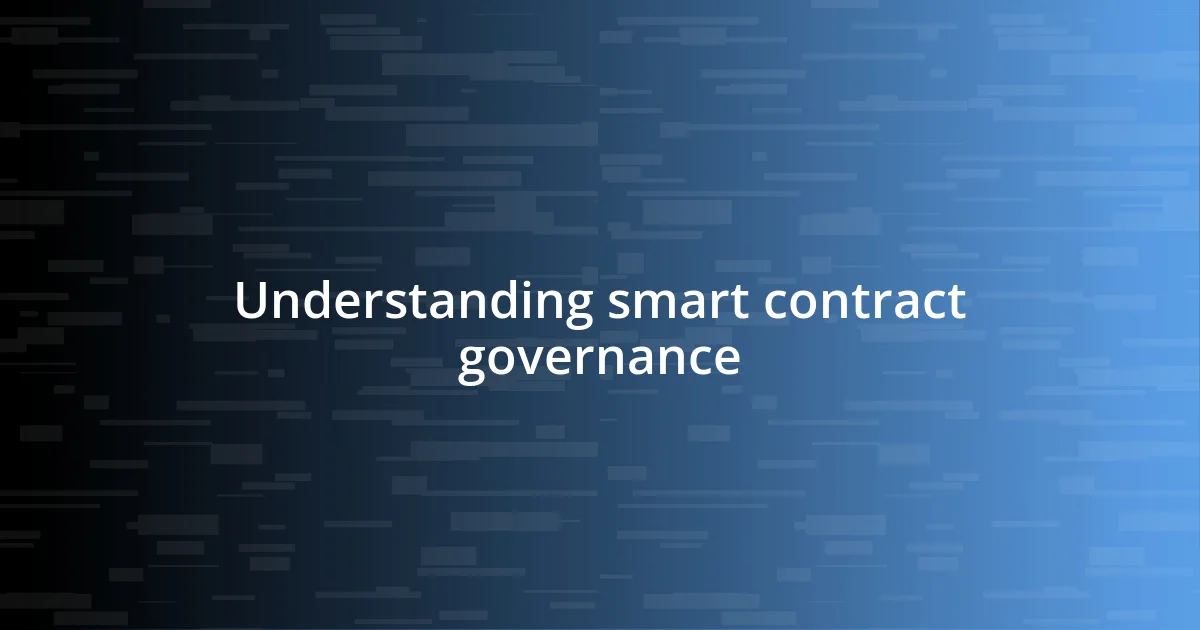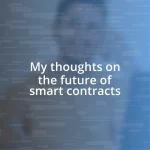Key takeaways:
- Effective smart contract governance requires clear roles, transparency, inclusivity, and adaptability to foster stakeholder engagement and trust.
- Utilizing dedicated governance platforms and real-time analytics tools enhances communication, decision-making processes, and community participation.
- Regular feedback loops and retrospective analyses are crucial for assessing governance effectiveness and ensuring it aligns with community needs and expectations.

Understanding smart contract governance
Smart contract governance is a fascinating intersection of technology and decision-making. I remember the first time I encountered it while exploring decentralized applications; it struck me how the rules encoded in a smart contract could potentially outlast the people who created them. Isn’t it wild to think that a series of coded instructions can dictate terms without human intervention?
The governance aspect comes into play when you consider who holds the power to modify or enforce these contracts. In my experience, I’ve seen projects struggle when there’s a lack of clarity in roles and decision-making processes, leading to disputes and inefficiencies. How can we ensure equitable governance when many stakeholders might have differing interests or motivations?
I often reflect on the balance between security and flexibility in smart contract governance. With rigid systems, there’s the risk of being locked into outdated agreements. Yet, if we become too flexible, do we risk losing the very security that smart contracts promise? This dilemma is something I believe every blockchain project grappling with governance needs to address proactively.

Core principles of governance strategies
Governance strategies in smart contracts must prioritize transparency, ensuring that all stakeholders can see decision-making processes and the rationale behind them. When I first participated in a governance forum for a blockchain project, I was struck by how clarity in communication helped foster trust among community members. This experience taught me that a transparent environment can significantly enhance collaboration and reduces the likelihood of misunderstandings that might derail progress.
Another core principle revolves around inclusivity. It’s crucial for governance models to accommodate diverse voices, especially in decentralized ecosystems where community input shapes the path forward. I vividly remember a governance decision that emerged from a community poll; it was enlightening to see how a simple line of feedback transformed our project trajectory. This taught me that including various perspectives not only enriches the decision-making process but also leads to solutions that resonate with a wider audience.
Lastly, adaptability stands as a fundamental principle in governance strategies. In my experience, the landscape of blockchain technology evolves rapidly; rigid approaches can stifle innovation and responsiveness. One project I worked on exemplified this: after initial governance strategies, we recognized the need to pivot and evolve based on community feedback and market trends. This flexibility not only kept us relevant but also cultivated ongoing engagement and loyalty among stakeholders.
| Core Principle | Description |
|---|---|
| Transparency | Ensuring that all stakeholders understand decision-making processes and their implications. |
| Inclusivity | Encouraging diverse contributions and perspectives to enrich the governance process. |
| Adaptability | Being willing to change governance strategies in response to new information and challenges. |

Defining roles in governance frameworks
Defining roles within governance frameworks is crucial for a well-functioning smart contract ecosystem. Without clearly delineated responsibilities, projects can fall into chaos, reminiscent of a ship without a captain. My experience with a decentralized finance (DeFi) platform highlighted this when miscommunication about roles led to conflicting decisions that frustrated not only the teams but the entire community. It was a wake-up call that taught me the importance of clarity in governance.
Here are some key roles to consider in a governance framework:
- Decision-Makers: Individuals or groups authorized to propose and implement changes.
- Advisors: Experts who provide guidance and strategic insights to help steer the governance process.
- Voters: Stakeholders who participate in decision-making by casting votes during governance proposals.
- Facilitators: Those responsible for organizing discussions and ensuring that all voices are heard.
- Auditors: Roles focused on monitoring the adherence to established governance protocols and ensuring accountability.
When I think about these roles, I can’t help but recall a specific instance where our voting process lacked proper outreach. This experience revealed how critical it is for roles to not only exist but to be actively engaged and recognized by all participants. Seeing overlooking this detail led to decisions that didn’t reflect community sentiment, which was disheartening for me personally. In my view, ensuring everyone understands their roles and feels empowered to contribute can drastically enhance the effectiveness of governance frameworks.

Tools for effective governance management
Effective governance management requires the right tools to streamline communication and decision-making processes. One tool that has made a significant impact for me is a dedicated governance platform, like Aragon or DAOstack. I remember trying to implement a proposal through a cumbersome email chain, and it felt like we were all speaking different languages. These platforms, however, provide a unified space where proposals can be clearly presented, debated, and voted on, fostering a sense of community and ownership in the governance process.
Another essential tool I’ve come across is real-time analytics dashboards. They enable stakeholders to visualize data related to governance activities and outcomes. There was a time when tracking engagement and feedback was a manual and tedious process, often leading to missed opportunities for improvement. By having an accessible dashboard that displays participation metrics, I’ve witnessed how it encourages more people to engage in the governance dialogue, knowing their voice matters. Have you ever felt hesitant to participate in a discussion because you weren’t aware of how the community was reacting? Having these tools eliminates that uncertainty.
Lastly, incorporating communication tools like Discord or Telegram has proven invaluable for fostering ongoing discussions. These platforms allow real-time interactions, which I found crucial when navigating complex decisions. During a heated debate over a potential funding allocation, being able to communicate instantly with other members helped us clarify our positions and reach a consensus faster than traditional methods allowed. Don’t you think that open channels for dialogue can bridge gaps that might otherwise widen? It certainly has in my experience, reinforcing the need for tools that enhance connectivity and responsiveness in governance management.

Monitoring and assessing governance effectiveness
To effectively monitor and assess governance effectiveness, I’ve found that you need to implement measurable criteria. Setting clear performance indicators can be enlightening. For instance, during a project I was involved with, we utilized participant engagement metrics to gauge how well our governance processes resonated with the community. It was fascinating to see how specific initiatives could either boost or hinder participation, and it taught me the profound impact of transparency on stakeholder confidence.
Regular feedback loops also play an essential role in understanding governance effectiveness. My experience with surveys and open forums revealed a wealth of information I hadn’t anticipated. I remember feeling surprised when we discovered that community members wanted more educational resources to better understand the proposals. This input reshaped our outreach strategies and strengthened the bond between the governance body and participants. After all, who better to assess the effectiveness than those directly impacted by the decisions?
Lastly, conducting retrospective analyses can provide invaluable insights into what truly works and what doesn’t. I recall a governance session where we analyzed previous voting results and community feedback. That day not only highlighted areas for improvement but also reaffirmed practices that were positively received. It’s a bit like taking a step back in a dance routine to ensure you’re not just moving to the music, but actually in sync with your partner. Isn’t it incredible how looking back can pave the way for more effective governance moving forward?

Enhancing community participation in governance
Enhancing community participation in governance is something I’m truly passionate about. One approach I’ve found effective is hosting regular town hall meetings—both virtual and in-person. I recall a time when we organized a local gathering where everyone could voice concerns and share ideas. The energy in the room was palpable as community members, who sometimes felt unheard, discovered they had allies in their thoughts and aspirations. It made me realize how powerful face-to-face interactions can be in building trust and encouraging more active participation.
Another strategy has been the introduction of incentive structures for participation. I remember a successful initiative where we offered small rewards for individuals who attended meetings or contributed valuable feedback. Surprisingly, this sparked enthusiasm and brought in voices that might have otherwise stayed silent. It often made me reflect: are we doing enough to recognize the efforts of those who engage? By acknowledging and celebrating participation, we cultivate a culture where everyone feels valued, and this, I believe, can significantly enhance community involvement.
Additionally, I’ve explored the impact of using storytelling within our governance discussions. Sharing personal experiences related to proposals adds a relatable dimension to the conversation. During one meeting, I shared a heartfelt story about how a proposed budget change could affect families in our community. I could see the shift in attention; people were genuinely engaged. It made me wonder why we don’t lean on our narratives more often. Tapping into the emotional connection can drive deeper participation—people want to support ideas that resonate with their own lives.














